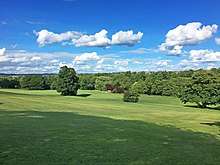Darley Park
Darley Park is an urban park on the banks of the River Derwent, just north of Derby City Centre, England, United Kingdom. It has a total area of 80 acres and forms the largest part of the Darley Open Spaces.[1] The park is one of Derby's most popular outdoor spaces.[2]

Description
The name Darley Park is often used to describe all or the separate parts that make up the Darley Open Spaces; a number of adjacent urban park areas that lie on either side of the banks of the River Derwent, at the gateway to the Derwent Valley Mills World Heritage Site. They are; Darley Park, Derwent Park, Parker’s Piece, Chester Green, Darley Fields and Nutwood Nature Reserve.[3]
At 80 acres, Darley Park is the largest of the areas. It is formed largely of steep bank that has a rise from the river level of about 30m.[4]
There are five main entrances to the Park, the closest to Derby city centre being at the southern point, off North Parade. Here there is also Handyside Bridge which offers a pedestrian route over to Parkers Piece and Chester Green.
Darley Park can also be accessed from the adjacent Derwent Park via pathways that lead from Duffield Road and Belper Road. There are two entrances from Darley Abbey Village; one off New Road and one at the northern point of the Park, next to Deans Field.
There are two official car parks for the park, one at the Darley Road entrance and one at Deans Field. Both of these car parks are free to use.








 Darley Fields
Darley Fields
History
In 1929 the Evans family, who were the local mill owners, donated the land Darley Park stands on to the people of Derby. The park had its official opening by the Duke of Kent on 30 June 1931. Nearby Markeaton Park was also opened later that day. Thousands of people attended the opening, including around 4,000 local children.
Included in the grounds was a Georgian mansion, however, this was demolished in the '60s due to the building being unsafe. The site of the mansion was flattened and a paved garden was installed, in addition to the gardens that were already in place. Some of the bricks from the original mansion were used in the construction of the pillars that make up the tearooms outdoor seating area today.[5]
Gardens
Darley Park is home to largest collection of Hydrangeas in Britain, and the third largest in the world. First planted in 1984 it now has over 400 different types and is constantly expanding. Since April 2010 the collection has been maintained in partnership with a subgroup of Friends of Darley Open Spaces (FoDOS) called Hydrangea Derby.[5]
The Hydrangea Derby project is helped by volunteers who plant, maintain and catalogue the collection. Open days are held each summer to showcase the collection and a free guided tour is provided.[6] There is a butterfly garden situated next to the hydrangea collection which boast an array of butterflies in the summer months.
Events
The Darley Park Concert is held annually in the park and is hosted by Derby Live. The natural amphitheatre landscape allows spectators to view down to a temporary stage set up and there is a firework finale. The concert was previously Europe’s largest free outdoor concert, however as of 2018 there has been admission fees in place. The concert was temporarily moved to Castle Donington in 2017 due to council funding issues.[7]
In 2012 the park hosted the end of day 42 in the 2012 Summer Olympics torch relay.[8]
Facilities
Darley Park Tearooms occupies the old school building, that was once part of the mansion, and has a terraced area that has views across the park and the city beyond. Darley Abbey Cricket Club has its ground and pavilion in the park. The club plays in the Derbyshire County Cricket League, Divisions 4 South, 7 South and 4 North. Derby Rowing Club is located at the south end of the park[9]. It has a function room that can be hired out for events.
Future Proposals
In February 2018 a controversial approval was made for the ‘Construction of a multi user path and ancillary works’. The proposal is for a boarded path to run from near the Abbey Inn to the Rowing Club, following the route of the river.[10] There has been much opposition by park users as to whether the path is necessary and will detract from the scenic surrounds. Those in agreement with the path say that it will give the park increased access and provide a suitable cycle route towards the city centre.[11]
References
- "Location Map". Streetmap. Retrieved 10 April 2018.
- "Reviews Darley Park". Trip Advisor.
- "Friends of Darley Open Spaces". friendsofdarleyopenspaces.org.uk. Retrieved 10 April 2018.
- "Elevation Finder". www.freemaptools.com. Retrieved 10 April 2018.
- "BBC - Derby - Around Derby - Darley Park". www.bbc.co.uk. Retrieved 10 April 2018.
- Parks, Derby. "Hydrangea Derby Open Day". Derby Parks. Retrieved 10 April 2018.
- Council, Derby City (5 September 2017). "Hannells Darley Park Concert welcomed back to Derby". Derby City Council Newsroom. Retrieved 10 April 2018.
- "Peak District to host torch relay". BBC News. 19 March 2012. Retrieved 11 April 2018.
- "Darley Abbey CC". darleyabbey.play-cricket.com. Retrieved 11 April 2018.
- "darley park path - Google Search". www.google.co.uk. Retrieved 10 April 2018.
- "Darley Park three-metre wide path plan: some fear it will be an eyesore". derbytelegraph. 13 February 2018. ISSN 0307-1235. Retrieved 10 April 2018.